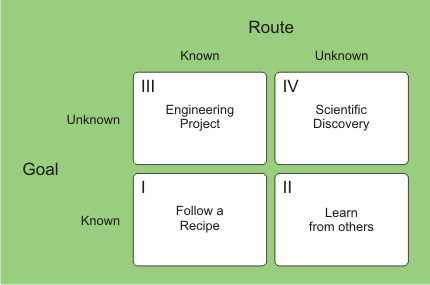
Discovery-driven innovation processes such as Lean Startup and Hypothesis-Driven Entrepreneurship are currently very much en vogue. They aim to solve the problem of reducing the uncertainty involved in developing successful new-to-the-world offers. In order to better understand the importance of discovery-driven innovation and how it compares to other types, we have developed the matrix shown above.
The matrix distinguishes between the innovation goal and the route needed to achieve that goal, each of which can be either known or unknown. The resulting 2×2 structure yields four quadrants, each of which represents a different type of innovation project.
- Quadrant I. Here, both the innovation goal and the route to achieving it are known. Incremental innovations are usually located in this quadrant. Customer feature requests and suggestions by members of the public obtained from idea portals are of this type. For example, customer suggestions such as „introduce a decaffeinated iced coffee“ or „bring back coconut syrup“ specify the goal, and Starbucks (presumably) knows how to go about implementing them directly. The metaphor of Quadrant I is that of a cook following a recipe. The strategic risk involved is concentrating on the wrong goal, so that while it might be achieved efficiently, it leads to an innovation which is ineffective, outdated or even irrelevant. This error has been likened to „straightening deck chairs on the Titanic.“
- Quadrant II. In this quadrant, the innovation goal is known, but the route to achieving it is not. This may occur when a customer asks for a solution that is outside the domain of expertise of the supplier. This would have been the case if the proverbial buggy whip manufacturer had been asked a hundred years ago to supply steering wheels to an automobile manufacturer. In this situation, a company might ask a university or a consultant for help. The metaphor is that of a student studying from a textbook. (The illegal practices of wilfully infringing a patent or reverse engineering a competitor’s product also belong to this category.) The strategic risk is choosing a poor source of information.
- Quadrant III. In Quadrant III innovation, a company does not know what the end result will look like, but it does have an established procedure for developing it. This is the case, for example, when the next model of a successful automobile is to be developed; the manufacturer does not know the final product, but has a tried and trusted method for getting to it. The metaphor for this type of innovation is thus the manager running an traditional engineering project. The strategic risk involved in this case is shooting at the wrong target, i.e. setting the wrong goal at the outset of the project and developing a product that nobody wants. The Edsel, Webvan and Segway are three well-known examples of products that did not meet their marketing goals for this reason.
- Quadrant IV. In the last case, neither the final product nor the route to finding it are known. This is the situation in which startups usually find themselves. The metaphor in this case is the scientist searching for new knowledge using an iterative process of hypothesis and experimentation. The Lean Startup approach proposed by Steve Blank follows this method. For established companies, we call this approach Discovery-Driven Innovation. The strategic risks involved here are asking the wrong questions or misinterpreting the answers received.
The largest opportunities for growth are usually to be found in Quadrant IV, since it is here that new markets meet new types of solution. However, the Lean Startup in its current form is insufficient to meet the needs of established companies. This was our motivation for developing Discovery Driven Innovation, which follows the basic hypothesis-driven method but also takes into account the additional issues that established companies have to deal with.
The motivation for the Lean Startup as described by Steve Blank is that startups which are in Quadrant IV use methods which are appropriate for Quadrant III: they set up and execute a waterfall innovation process without either knowing the customer needs or possessing an appropriate solution for them. We believe that the model presented here helps to explain this difference a little better, while at the same time taking two further types of innovation into account.
Zuletzt aktualisiert am 20. März 2024 von Graham Horton
